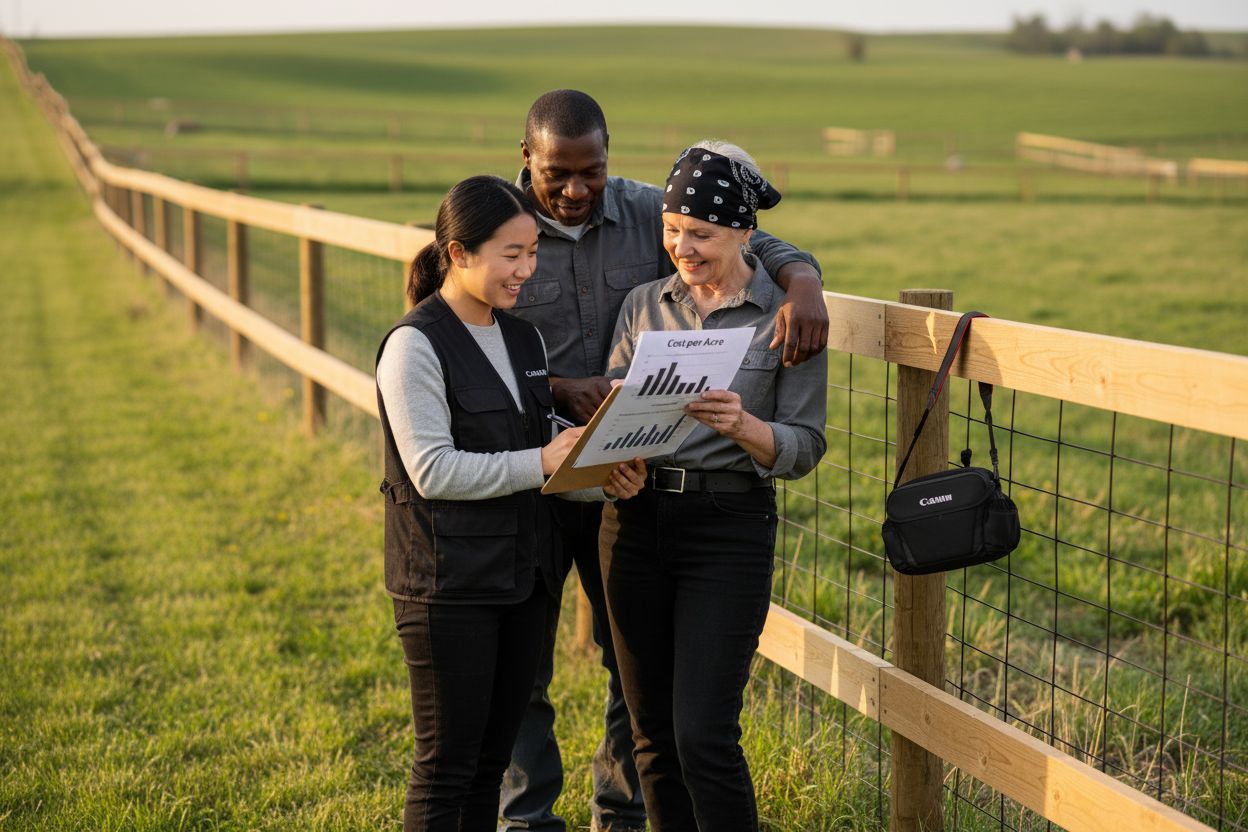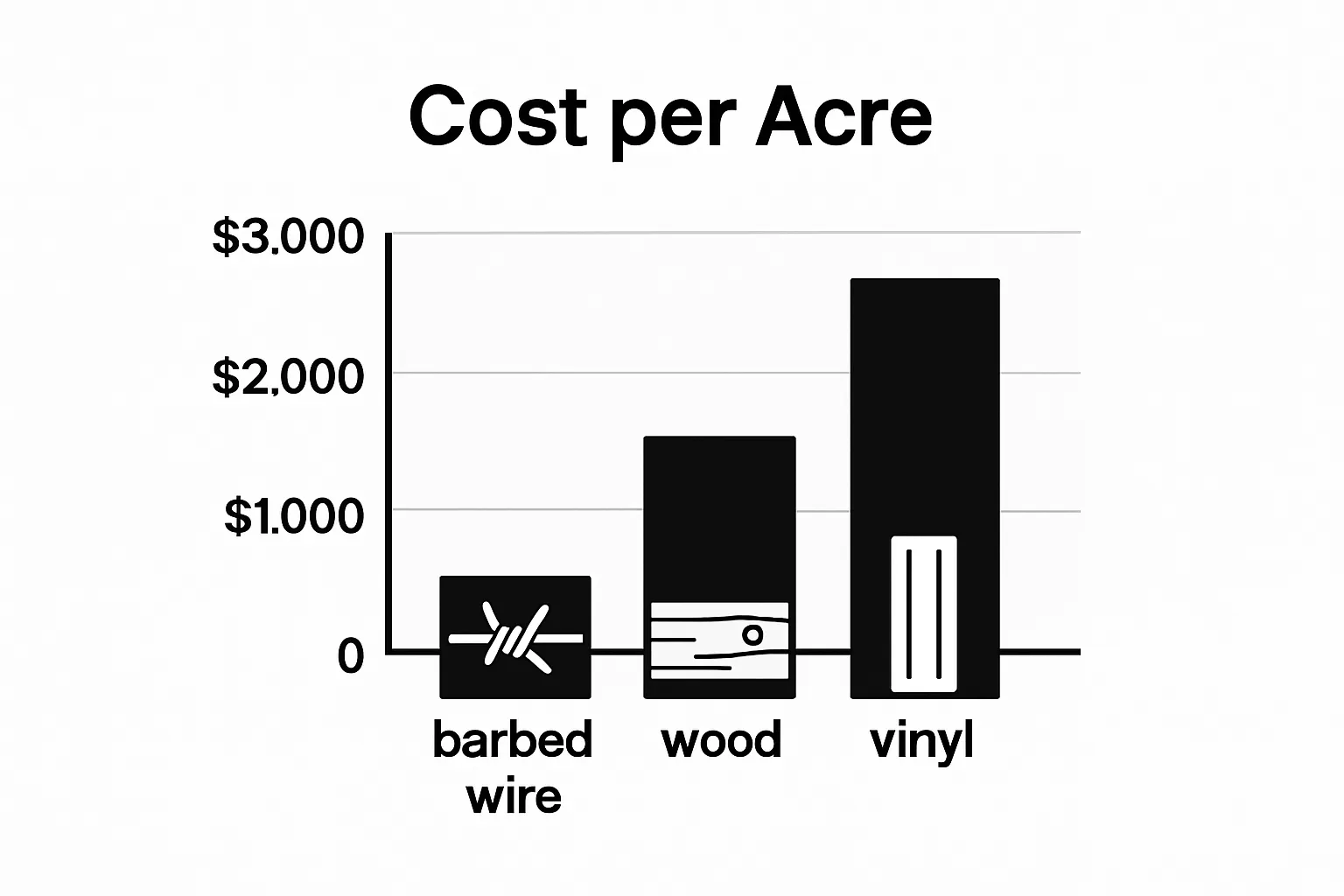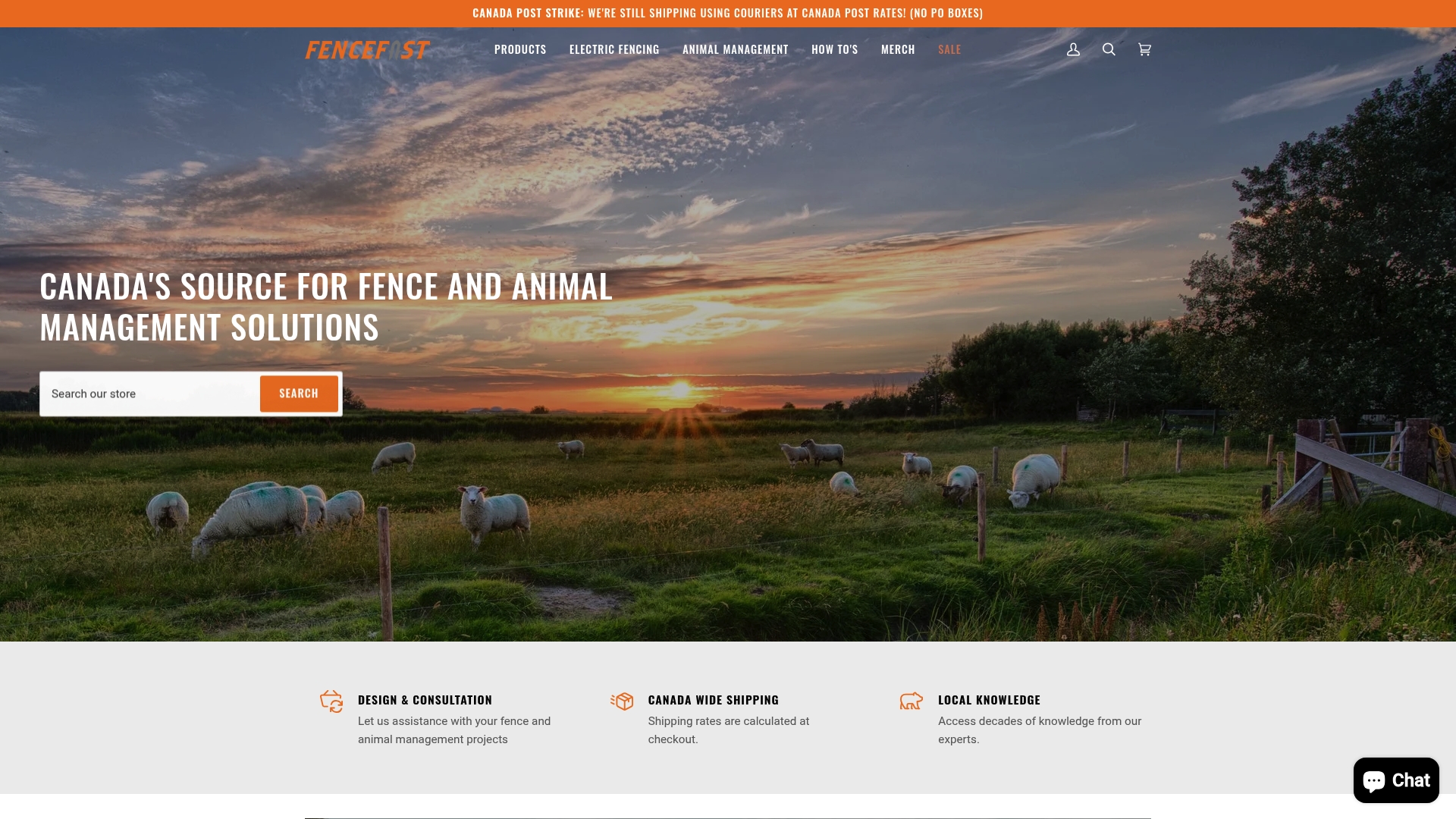Fencing a property is more than just marking your land. It shapes how you manage livestock, protect crops, and secure boundaries. And get this. A single acre is exactly 43,560 square feet, but the actual cost to enclose it can swing wildly depending on what you choose and where your land sits. You might think a straight-line calculation would do the job, but irregular boundaries and rugged terrain mean most owners end up needing clever measurement tricks instead.
Table of Contents
- What Is Fencing And How Is It Measured Per Acre?
- Why Knowing The Cost Of Fencing Per Acre Is Important
- Factors Influencing The Cost Of Fencing Per Acre
- Understanding Different Types Of Fencing Materials
Quick Summary
| Takeaway | Explanation |
|---|---|
| Accurate acreage measurement is essential. | Utilize GPS, surveying tools, or satellite imagery for precision in measuring property area. |
| Fencing costs impact financial planning. | Understanding total expenses aids in budget management and potential return on land investment. |
| Material choices significantly affect cost. | Evaluate durability and access challenges when selecting materials for your fencing project. |
| Proper fencing enhances operational efficiency. | Effective fences prevent livestock loss and legal disputes, improving property management and resource use. |
| Consider long-term maintenance in planning. | Analyze not only initial costs but also ongoing upkeep and performance over the fencing’s lifespan. |
What is Fencing and How is it Measured Per Acre?
Fencing represents a critical infrastructure component for agricultural, livestock, and property management, serving multiple purposes beyond simple boundary demarcation. When considering the cost of fencing per acre, property owners must understand the fundamental aspects of land enclosure and measurement strategies.
Understanding Fencing Fundamentals
Fencing involves creating physical barriers around specific land areas using various materials and techniques. These barriers can serve diverse purposes such as livestock containment, crop protection, security, and property delineation. Learn more about effective land management strategies to complement your fencing approach.
Measuring fencing per acre requires precise calculations that consider several critical factors:
- Total land perimeter length
- Terrain complexity
- Specific fencing material chosen
- Required fence height and density
Acreage Measurement Techniques
Accurate acreage measurement forms the foundation for determining fencing requirements. Professional surveyors and agricultural experts typically employ multiple methods to calculate land area, including:
- Global Positioning System (GPS) technology
- Traditional land surveying equipment
- Satellite imagery mapping
- Digital mapping software
The standard acre measurement represents 43,560 square feet, which translates to approximately 208.71 feet on each side of a perfectly square plot. However, real-world land parcels rarely conform to such geometric precision, necessitating more nuanced measurement approaches.
Understanding your specific land characteristics helps determine the most appropriate fencing strategy and accurately estimate the cost of fencing per acre.
Property owners must consider terrain variations, intended use, and long-term maintenance requirements when planning their fencing project.
Why Knowing the Cost of Fencing Per Acre is Important
Accurate understanding of fencing costs is fundamental for agricultural and rural property management, directly impacting financial planning, operational efficiency, and long-term investment strategies. Explore essential tools for fence building to better understand the comprehensive requirements of fencing projects.
Financial Planning and Budgeting
The cost of fencing per acre represents a significant capital investment that can substantially influence overall property development and maintenance expenses. Property owners must conduct comprehensive financial assessments that consider multiple economic factors:
- Initial material and installation expenses
- Long-term maintenance costs
- Potential return on investment through improved land utilization
- Future property value enhancement
According to agricultural economic research, strategic fencing investments can yield substantial economic benefits by improving land management efficiency and protecting valuable agricultural assets.
Operational Efficiency and Asset Protection
Knowing fencing costs goes beyond mere financial calculations. Proper fencing directly contributes to operational effectiveness by:
- Preventing livestock loss and property encroachment
- Reducing potential legal disputes with neighboring landowners
- Enabling precise land segmentation and resource management
- Protecting crops and agricultural investments from wildlife damage
Professional agricultural managers understand that well-planned fencing is not an expense but a strategic investment in property infrastructure. The upfront cost of fencing per acre translates into long-term operational advantages, risk mitigation, and potential revenue generation through improved land use and asset protection.
Ultimately, comprehensive understanding of fencing costs empowers property owners to make informed decisions, balancing immediate financial constraints with strategic long-term planning and agricultural productivity.
Factors Influencing the Cost of Fencing Per Acre
Understanding the complex variables that impact fencing expenses is crucial for accurate budgeting and planning. Discover the best fencing solutions for small farms to help navigate these intricate considerations.
Material Selection and Terrain Complexity
The cost of fencing per acre varies dramatically based on material choices and land characteristics. Property owners must evaluate multiple interconnected factors that directly influence overall project expenses:
- Fence material durability and quality
- Terrain topography and accessibility
- Land gradient and soil composition
- Distance between fence posts and installation requirements
According to agricultural infrastructure research, material selection represents the most significant determinant of fencing costs, with options ranging from economical wire installations to more expensive wooden or specialized metal configurations.
Labor and Installation Considerations
Beyond raw material expenses, professional installation introduces additional cost layers that property owners must carefully evaluate:
- Geographic location and regional labor rates
- Equipment and machinery requirements
- Complexity of terrain and land preparation needs
- Professional expertise and specialized skills required
Rural and agricultural environments present unique challenges that can substantially impact fencing installation expenses. Remote locations, challenging terrain, and limited equipment access can exponentially increase overall project costs.
Proper planning, comprehensive site assessment, and strategic material selection enable property owners to optimize their fencing investments, balancing immediate expenses with long-term durability and performance requirements. Sophisticated decision-making considers not just upfront costs, but the total lifecycle economic impact of fencing infrastructure.
Below is a table outlining the main factors that influence the total cost of fencing per acre, along with how each factor impacts your overall investment.
| Factor | Description | Impact on Cost |
|---|---|---|
| Material selection | Choice of fencing material (wire, wood, vinyl, metal, composite, etc.) | Most significant |
| Terrain complexity | Land gradient, soil composition, and obstacles (rocks, trees, slopes) | Moderate to high |
| Labor and installation rates | Local labor costs, expertise, required equipment | Moderate to high |
| Fence height and density | Tall/frequent post fencing increases material and labor costs | Moderate |
| Perimeter length | Size and shape of property affect total fencing required | Directly proportional |
| Maintenance requirements | Long-term upkeep and repair costs | Ongoing |

Understanding Different Types of Fencing Materials
Choosing the appropriate fencing material is crucial for long-term property management and agricultural success. Learn about essential livestock fencing types to make informed decisions about your land infrastructure.
Wire-Based Fencing Options
Wire fencing represents a versatile and cost-effective solution for agricultural and rural properties. The primary wire fencing categories include:
- Barbed wire: Economical and suitable for large livestock containment
- Smooth wire: Provides minimal resistance and lower injury risks
- High-tensile wire: Offers superior durability and longer-term performance
- Woven wire: Creates dense barriers for smaller livestock and wildlife control
Agricultural material research indicates that wire fencing materials provide exceptional flexibility across diverse agricultural environments, with each variant offering unique performance characteristics.
Solid Fencing Material Alternatives
Beyond wire-based solutions, property owners can select from multiple solid fencing materials that offer distinct advantages:
- Wooden posts and rails: Traditional aesthetic and natural appearance
- Vinyl and synthetic materials: Low maintenance and long-lasting durability
- Metal panel fencing: Robust protection with minimal long-term maintenance
- Composite materials: Blend of durability and environmental sustainability
Each material presents unique cost considerations, performance metrics, and aesthetic implications.
To help you compare the various fencing material options discussed, here is a table summarizing their key features and typical uses.
| Fencing Material | Durability | Maintenance Needs | Common Uses | Cost Impact |
|---|---|---|---|---|
| Barbed wire | Moderate | Low | Large livestock, basic boundaries | Low |
| Smooth wire | Moderate | Low | Low-injury containment, flexibility | Low |
| High-tensile wire | High | Low | Durable, long-term fencing | Moderate |
| Woven wire | High | Moderate | Small livestock, wildlife control | Moderate-High |
| Wooden posts and rails | Moderate | High | Traditional look, visible boundaries | High |
| Vinyl/synthetic | High | Low | Low maintenance, long lifespan | High |
| Metal panel | Very High | Very Low | Secure boundaries, resilient fencing | Very High |
| Composite materials | High | Low-Moderate | Sustainable option, varied application | High |
 Professional agricultural managers must balance immediate installation expenses with long-term durability, maintenance requirements, and specific land use objectives when selecting fencing materials.
Professional agricultural managers must balance immediate installation expenses with long-term durability, maintenance requirements, and specific land use objectives when selecting fencing materials.
Ready to Take Control of Your Fencing Costs and Boost Farm Efficiency?
If you are struggling with unpredictable expenses and feeling overwhelmed by the complexity of fencing per acre, you are not alone. Planning around material selection, terrain differences, and ongoing maintenance can make financial decisions a real challenge. Your land deserves better protection and smarter investment. At FenceFast.ca, you will find a complete range of tools and expertise tailored for agricultural and rural property owners just like you. With everything from fencing systems to livestock management solutions, we help turn your cost concerns into practical, long-lasting results you can trust for every acre on your property.

Stop letting uncertainty limit your progress. Visit FenceFast.ca to explore our fencing components and electric fencing systems designed for Canadian farms and ranches. Need help choosing or planning your next project? Check out our design consulting services and discover expert support along with a seamless online ordering experience. Take control of your land and your budget—shop, plan, and protect with confidence today.
Frequently Asked Questions
What factors influence the cost of fencing per acre?
The cost of fencing per acre is influenced by several factors, including the selection of materials, site terrain complexity, labor and installation costs, and the specific requirements for fence height and density.
How do I measure the acreage for fencing accurately?
Accurate acreage measurement can be achieved using Global Positioning System (GPS) technology, traditional surveying equipment, satellite imagery mapping, and digital mapping software. Understanding the perimeter length is essential for calculating fencing requirements.
What are the different types of fencing materials I can choose from?
Fencing materials vary widely and include wire-based options such as barbed wire and smooth wire, as well as solid materials like wooden posts, vinyl, metal panels, and composite materials, each with distinct advantages and costs.
What are the long-term benefits of investing in quality fencing?
Investing in quality fencing can lead to enhanced operational efficiency, reduced livestock loss, better property protection, and improved land management, ultimately contributing to increased property value and productivity.
